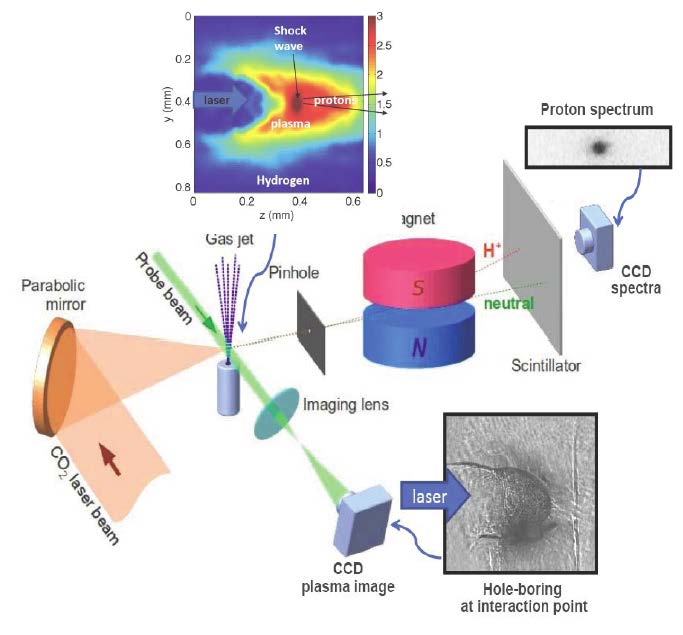- Home
- Capabilities
- Science Highlights
- Operations
- Publications
-
ES&H
- Experiment Start-up
- Laser Safety
Collider-Accelerator Dept.
- C-AD ES&H Resources
- Staff
- Users' Place
- Apply for Access
First Demonstration of MeV Mono-energetic Laser-driven Proton Source by Shock Wave Acceleration
Only two facilities worldwide operate picosecond CO2 lasers for advanced accelerator research, the Neptune Laboratory at UCLA and the ATF at BNL. Both recently reported successful demonstration of ion acceleration using gas jets [1, 2]. Figure 1 shows the set-up for the proof-of-principle ATF user experiment, undertaken collaboratively by researchers from Imperial College, London, and SUNY at Stony Brook. The CO2 laser pulses were circularly polarized, with energy between 2 J and 4 J. The temporal structure of the drive beam consisted in short trains of 5 ps pulses each separated by 20 ps, where most (~80%) of the laser’s energy was confined within the first two pulses. Figure 1-45. Schematic of the ATF ion acceleration experiment.

Schematic of the ATF ion acceleration experiment.
The CO2 laser beam is focused on a cylindrical hydrogen gas jet of 1mm diameter with an f/3 off-axis parabolic mirror to a focal spot of w0=60 µm diameter. The measured contrast ratio of the laser was 10-7. Modulating the backing pressure of the gas jet allowed varying plasma densities in the range of n=1.3-8ncr. The generated ion beam was characterized using a magnetic spectrometer. The resulting ion track was then recorded using a scintillator and an EMCCD camera. While the gas-jet target is over-dense to the CO2 drive beam, it is under-dense to optical radiation, and thus sufficiently transparent for optical probing, as was demonstrated with a frequency doubled YAG beam (? = 527 nm). The probe beam was directed transversely to the CO2 propagation axis and split into two separate channels, one for shadowgraphy imaging of the interaction region, the other to measure the density profile by interferometric techniques. The timing of the probes with the CO2 drive pulse was changed to probe different instants of the interaction.
[1] Palmer, C.A.J., et al.,
Monoenergetic Proton Beams Accelerated by a Radiation Pressure Driven Shock. Phys Rev Lett, 2011.
106(1): p.014801.
[2] Haberberger, D., et al., Production of Multi-Terawatt Time-Structured CO2 Laser Pulses for Ion Acceleration. AIP Conf. Proc. 1299, June 13-19, 2010: p. 737.




